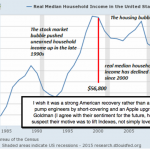The two most important factors in determining the level of sovereign bond yields are the credit and inflation risks extant within a nation. When determining a country’s ability to service its debt investors must analyze not only the absolute debt level but also the ratios of debt and deficits to GDP. In addition, the current rate of inflation must also be viewed within the context of debt in order to make an accurate assumption as to the level of future inflation.
When analyzing historical measures of these criteria, the conclusion reached is that the U.S. 10-year Note yield should rise to at least four percent in the coming quarters.
The last time long-term interest rates were not the preoccupation of central banks was before the Great Recession, which began in December of 2007. Therefore, it is important to view where the 10-year Note was trading at that time in relation to inflation, the absolute level of debt, as well as debt and deficits to GDP.
The average yield on the 10-year Note was 4.6% during that year, with a high water mark of 5.23%. According to the BLS, Consumer Price Inflation (CPI) averaged 2.8%. The debt to GDP ratio was just 61%, and the annual deficit registered a paltry 1.1% of the economy. Importantly, the level of Publicly Traded debt was $5.1 trillion back in 2007.
Turning to the conditions of today, the 10-year Note yield has dropped to just under 2.9%; but those same metrics are foreboding much higher interest rates to come. While CPI averaged 2.1% last year, a mere 0.7 percentage points below 2007, debt levels have become gargantuan and are projected to skyrocket “big league” from here. As of the end of 2017, the debt to GDP ratio shot up to 103% of GDP, and the level of Publicly Trade Debt climbed to $14.8 trillion, which helped elevate the Deficit to a much higher—but still manageable compared to where we are headed–3.4% of GDP.
Therefore, it is rational to conclude that the Benchmark Treasury yield would already be greater than the 4.6% average seen back in 2007 if it were not for the still massive–but now rapidly waning–bid from global central banks.
However, the interest rate dynamics get much worse from there. In fiscal 2019, which begins this October, the deficit to GDP ratio is going to absolutely go into warp drive. The baseline scenario is for a $1.2 trillion deficit next fiscal year, according to the Committee for a Responsible Federal Budget. But you also must add to that figure the $360 billion worth of Treasury sales from the Federal Reserve. Therefore, the deficit to GDP then catapults to 7.5% of GDP. And if you add in the $240 billion worth Mortgage Backed Security sales from the Fed, which the primary dealers must also absorb and will crowd out Treasury purchases, the deficit rises to an incredible 8.6% of GDP!












Leave A Comment